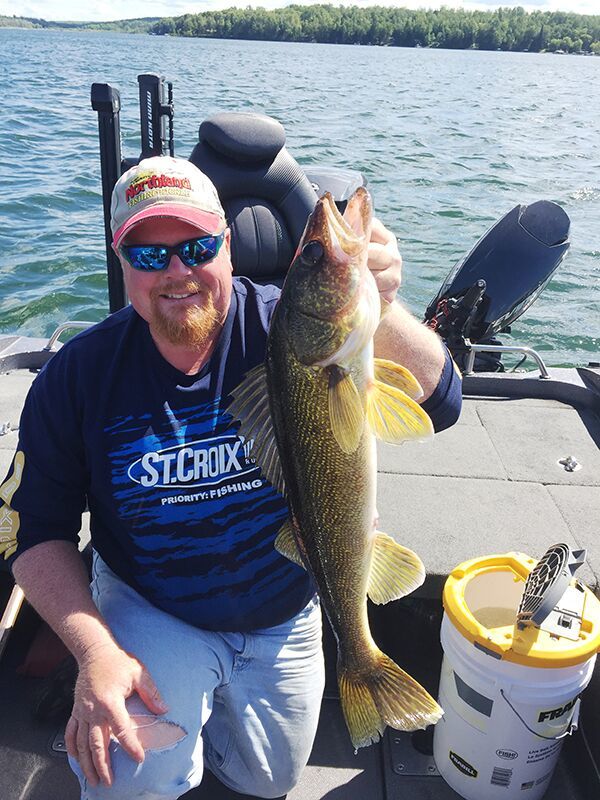
Leech Lake in north-central Minnesota is a clear-water lake with 112,000 acres. There is a wide range of habitat in Leech too, which helps support the diverse fishery for walleye fishing.
This lake has deep clear bays, like Walker Bay, which reach nearly 200 feet deep. And there are shallow, weedy bays, like Steamboat and Boy bays, which are mostly shallow, except for the old creek channels.
Leech Lake has many large bays feeding the main lake. All have plenty of weeds and rocks with moderate depths in the middle. Most of the structure here is shoreline-connected, and there is also has a huge windswept main lake with islands, flats, and humps. Most of the basin areas here are shallower than 40 feet deep, except for two deeper trenches. The lake is widely considered as one of the “Top Five Walleye Lakes” within Minnesota.
Increasing fishing pressure, along with the current state of the walleye population in Leech, has prompted the Minnesota DNR to set the limit in 2016 at four walleyes with a protected slot of 20 to 26 inches, and with one walleye longer than 26 inches allowed in a limit.
Surface water temperatures give anglers one of the biggest clues to what the walleyes are likely doing in any given situation. Keep in mind that these temperatures are most accurately measured early in the morning before the sun warms the water.
Once the spawn finishes, walleyes focus on finding plentiful food sources. Many spawn in the north ends of Portage and Sucker bays, so they will start to work their way down these after the spawn, eventually heading for the main lake or the deep waters in Walker Bay. Walleyes in Leech usually feed their way out of the bays along with shoreline structures, searching for spawning spottail shiners and perch. I’ll watch my Humminbird Helix 10 on Side Imaging mode at 100 to 150 feet, looking for schools of fish without driving over them.
The water is clear here, so it usually takes wind or overcast skies to generate a good walleye bite in the shallow water. Many anglers make long drifts along the windward shore or over the top of flats. When they catch a fish, they mark the spot on GPS and try to adjust future drifts back through the most productive areas.
There are usually several identifiable community hot spots on Leech. The flotilla of boats is seen on the hot spots on weekends, especially next month, while fewer are present on the weekdays. Anglers can try to stay away from the crowds and find walleye, but often, the boats are there because they have located a big school.
Larger angling groups need to pay attention to their presentations so their baits stand out from the crowd and get more action. If fish aren’t biting, try something different until you find their preference. My personal favorite presentation for walleyes early in the season is a jig and spottail shiner minnow fished on a medium- or medium-light-action rod paired with Sunline SX1 Dark Green braid for the line. The jig I use depends on the bottom type, depth, and the amount of wind. I really like the 3/16-ounce Northland RZ when fishing in sparse weeds. I like long-shank jigs because I can double-hook the shiner minnow, which makes it semi-weedless and helps catch any short-biting fish.
When I fish for walleyes on rocks, I prefer a 1/16-ounce jig with a short shank so I don’t get snagged. I hook the spottail shiner minnow in the mouth and out the shoulder behind the head. I like the Stand-up Fire-Ball Jig for casting and the Round Fire-Ball Jig for controlled drifting or trolling.
I will continue to fish jigs and spottail shiners as long as the bait stores have them. They can be tough to keep alive, so I use a 6-gallon aerated bait bucket to hold the bulk of my minnows in the boat. I use a smaller bait box to pass minnows around the boat.
Once spottail shiners leave the shallows, walleyes need to find another “easy,” abundant food source. This usually means most of the walleyes will leave the shallow bays and head for the main lake. The next item on the seasonal menu for walleyes are insect hatches that begin as soon as water temperatures reach the 60s.
The explosion of food in deep water will attract perch, minnows, and fish of all sizes into the basin to feed. Walleyes can cruise the edges of mid-lake structures along with the transition from a hard to a soft bottom, where they can feast on a smorgasbord of minnows, crayfish, and bugs.
There are also crayfish, perch, and minnows on the medium-depth, chara-covered flats, which will also draw some of the walleyes as they migrate out of the shallow bays.
Some stay in the weeds all summer long, so there are usually walleyes using several different patterns at the same time during the summer. When they move out of the shallows, many anglers switch to live bait rigs with either leeches or nightcrawlers. Anglers can also use larger minnows on live bait rigs.
Summer patterns will take over the lakes once the surface water temperatures reach 70 degrees. Walleyes are more likely to take faster-moving baits in the warm water, with anglers switching to Rock Runner bottom- bouncers with Baitfish Spinner Harnesses and either nightcrawlers or leeches on a single-hook harness.
Trolling crankbaits is also a productive presentation in Leech Lake during the summer, especially at low light or after dark during the full moon period, or during the day when the water hits the mid-70s.
Brian “Bro” Brosdahl is a nationally known fishing guide and lead spokesman for many of the top companies in ice fishing. He can be contacted at [email protected] or through his website at brosguideservice.com. Follow him on Instagram, Twitter, and Facebook.

